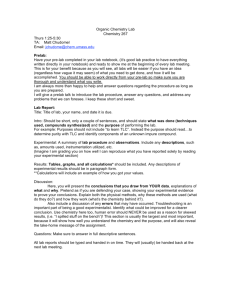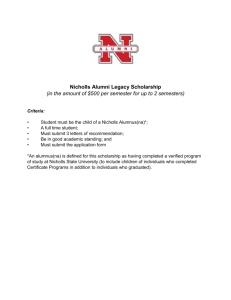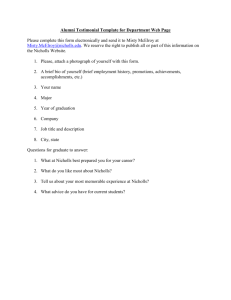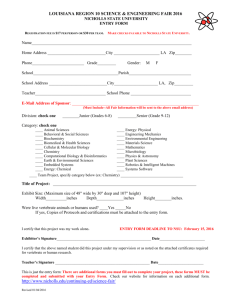Syllabus Chem 110 ed format
advertisement
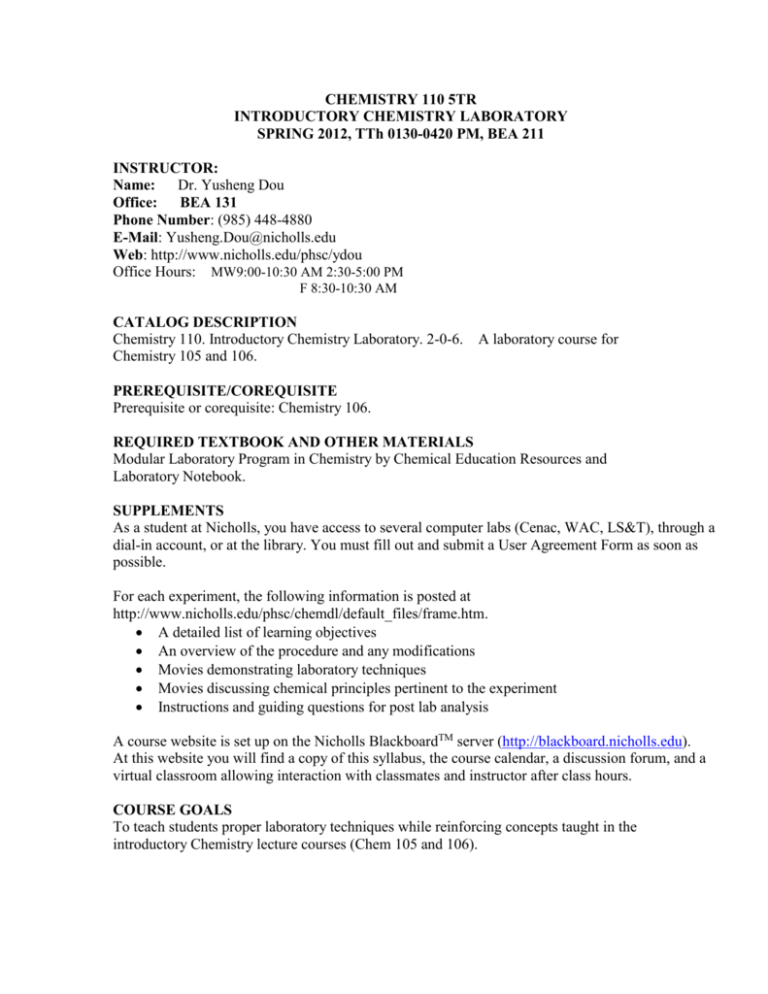
CHEMISTRY 110 5TR INTRODUCTORY CHEMISTRY LABORATORY SPRING 2012, TTh 0130-0420 PM, BEA 211 INSTRUCTOR: Name: Dr. Yusheng Dou Office: BEA 131 Phone Number: (985) 448-4880 E-Mail: Yusheng.Dou@nicholls.edu Web: http://www.nicholls.edu/phsc/ydou Office Hours: MW9:00-10:30 AM 2:30-5:00 PM F 8:30-10:30 AM CATALOG DESCRIPTION Chemistry 110. Introductory Chemistry Laboratory. 2-0-6. A laboratory course for Chemistry 105 and 106. PREREQUISITE/COREQUISITE Prerequisite or corequisite: Chemistry 106. REQUIRED TEXTBOOK AND OTHER MATERIALS Modular Laboratory Program in Chemistry by Chemical Education Resources and Laboratory Notebook. SUPPLEMENTS As a student at Nicholls, you have access to several computer labs (Cenac, WAC, LS&T), through a dial-in account, or at the library. You must fill out and submit a User Agreement Form as soon as possible. For each experiment, the following information is posted at http://www.nicholls.edu/phsc/chemdl/default_files/frame.htm. A detailed list of learning objectives An overview of the procedure and any modifications Movies demonstrating laboratory techniques Movies discussing chemical principles pertinent to the experiment Instructions and guiding questions for post lab analysis A course website is set up on the Nicholls BlackboardTM server (http://blackboard.nicholls.edu). At this website you will find a copy of this syllabus, the course calendar, a discussion forum, and a virtual classroom allowing interaction with classmates and instructor after class hours. COURSE GOALS To teach students proper laboratory techniques while reinforcing concepts taught in the introductory Chemistry lecture courses (Chem 105 and 106). STUDENT OUTCOME OBJECTIVES At the end of this course, students will be able to Use common laboratory equipment properly and safely Maintain laboratory notebooks and write reports adhering to generally accepted scientific practices and formats Demonstrate a thorough understanding of general chemistry principles covered in the laboratory experiments. Specific learning objectives are provided in the handout for each experiment. TENTATIVE OUTLINE OF COURSE CONTENT The following topics will be addressed in the experiments. A detailed schedule is attached. Accuracy and Precision of Measurements Stoichiometry: Preparation of solutions, Standardization of NaOH solution, Determination of Acetic Acid in Vinegar, The Reaction of Magnesium with Hydrochloric Acid, Percentage of water in hydrate Graphing Techniques: manual and computer-aided (Excel) Thermochemistry (Reaction calorimetry) Colligative Properties (Determination of molar mass from freezing point depression data) Reactions in Aqueous Solutions (“9-bottles problem”) Chemical Kinetics (Spectrophotometric monitoring) Chemical Equilibria: Le Chatelier’s Principle, Ionic Equilibria (Ka, Kb, Ksp), Qualitative Analysis Electrochemistry (Galvanic Cells) Synthesis (Soap or Aspirin) METHOD OF EVALUATION AND COURSE REQUIREMENTS Your grade will be based on the your average on Lab Notebook, Data Sheets and Answers to Questions, Post-lab Reports, Midterm Exam, Final Exam. Grades: A: >90%, B: 80-89%, C 70-79%, D, 60-69%, F <60%. Exams. The midterm (20 points) and final exam (30 points) will generally involve problem solving and include practical components (short laboratory and computer procedures). Post-Lab Reports. You are required to write two formal post-lab reports (10 points each): one for ANAL 503: Ionic reactions in aqueous solutions and another one for THER 346: Enthalpy of neutralization. The format of the formal post-lab report will be taught in class but it should be in narrative form and include: an introduction of the experiment, a brief overview of what you did in the lab, the results (tables, figures, and graphs summarizing the observations and data obtained), and an interpretation of the results. Keep in mind the stated learning objectives in the pre-lab lectures and handouts. A significant part of your report grade will depend on how well attainment of these objectives is demonstrated in the narrative. Two students work in group and share experimental results. However, each one should write your own post lab reports. If two post lab reports are found to be identical, both will obtain a zero. Post-lab report score= (raw score) x 20 / (maximum possible raw score) Lab Notebook. (30 points) The required laboratory notebook can be purchased from the bookstore. Make sure you press hard when writing on your notebook and that the cardboard is behind the duplicate page so that you have a legible duplicate. All entries must be done in INK. DO NOT erase any entries. If you make a mistake, draw a line through it --- it should remain legible. Before you are allowed to perform an experiment, your laboratory notebook must have the following entries (one page): a title, list of learning objectives, a summary of the experiment to be performed in complete sentences. As you perform the experiment, write what you did using complete sentences and record observations and raw data directly on the notebook. After completing each experiment, you must complete data analysis and question answers. Duplicates (yellow pages) must be submitted before you leave for the day and is worth 10 points. Lab Notebook Score = (raw score) x 30 / (maximum possible raw score). ACADEMIC DISHONESTY POLICY Any student found cheating will be subject to the penalties stated in Code of Student Conduct; including, but not limited to, a score of zero on exam, expulsion from the class, or expulsion from the University. ATTENDANCE Attendance is important to the success of this class and will be measured each class. For each and every absence, 5 points will be reduced from your class grade. MAKE-UP If you can not make a specific experiment, you have to inform your instructor in advance so that you might be arranged to another section for the same experiment. No make-up for both exams is applied. ACADEMIC HONESTY University policy, as detailed in the NSU Code of Student Conduct will be followed. Maximum penalty = F. DISABILITY STATEMENT If you have a documented disability that requires assistance, you will need to register with the Office of Disability Services for coordination of your academic accommodations. The Office of Disability Services is located in 158 Shaver. The phone number is (985) 448-4430 (TDD 449-7002). ACADEMIC GRIEVANCES The proper procedure for filing grade appeals or grievances related to academic matters is listed in Section 5 of the Code of Student Conduct and at the following link: http://www.nicholls.edu/documents/student_life/code_of_conduct.pdf. CONTINUED LEARNING FOLLOWING AN EXTREME EMERGENCY The following guidelines are meant: to help the business of education continue at Nicholls State University in the aftermath of an extreme emergency situation; to help faculty and students understand their roles in completing education requirements for courses in progress when emergency began; and to encourage faculty to be imaginative and resourceful in finding ways to continue the education of students and the work of the university. Faculty responsibilities: Faculty members are responsible for their development in the use of the Blackboard software. Faculty members are responsible for having a plan for continuing their courses using only Blackboard and email. Faculty members should be allowed to continue their courses in whatever way suits the completion of the course best and are encouraged to be creative in the continuation of these courses. Any adjustments or compensations, made to a student’s progress in special programs with labs, clinical sequences, or the like, should be made only in the immediate semester following the emergency. Student responsibilities: Students are responsible for reading regular emergency notifications on the NSU website. Students are responsible for knowing how to use and access Blackboard. Students are responsible for being familiar with emergency guidelines. Students are responsible for evacuating textbook and other course materials. Students are responsible for knowing their Blackboard student login and password. Students are responsible for contacting faculty regarding their intentions for completing the course. SEMESTER WITHDRAWALS The last day to drop the course with an automatic W is Wednesday, April 4, 2012. SAFETY Students must obtain a 100% score on the Safety Quiz and sign a Safety Agreement form after being briefed about the safety rules. Any students who violate a safety rule will be expelled from the laboratory, and will be considered to have an unexcused absence for that day. SPRING 2012 CHEM 110 Lab. Schedule Date Jan 19 Th Jan 24 T Jan 26 Th Jan 31 T Feb 2 Th Feb 7 T Feb 9 Th Feb 14 T Feb 16 Th Feb 23 T Feb 28 Th March 1 Th March 6 T March 8 Th March 13 T March 15 Th March 20 T March 22 Th March 27 T March 29 Th April 3 T April 5 Th April 17 T April 19 Th April 24 T April 27 Th May 1 T Experiments Orientation, Safety NSU-001: Accuracy and Precision of Measurement NSU-001 and ANAL 517: Determining the Water Content of an Ionic Hydrate NSU-002: Aqueous Reaction, Part I NSU-003: Aqueous Reaction, Part II ANAL 503: Ionic Reactions in Aqueous Solutions (9Bottles) (First Post Lab Report) NSU-005: Preparation of Solution NSU-006 and ANAL 394: Molarity of NaOH + KHP ANAL 395: Titration of Vinegar NSU-007: Prelab Supplement for STOI 369 STOI 369: Stoichiometry of Mg + HCl Review Midterm MISC 371: Graphic Technique and Graphing with Excel PROP 500: Freezing Point Depression NSU-009 and 010: Prelab Supplement for THER 346, Part I and II THER 346: Enthalpy of Neutralization 2nd Post Lab Report ANAL 620: Paper Chromatography SYNT 439/PROP 319: Synthesis of Aspirin/Soap NSU-011: Prelab Supplement for KINE 504 KINE 504: Kinetics NSU-014: Aqueous Equilibria (Lecture) NSU-014: Aqueous Equilibria (Experiment) EQUL 404: Le Chatelier’s Principle ELEC 450: Electrochemical Cells Review, Check - Out Final ***THIS SYLLABUS IS NOT A CONTRACT AND IS SUBJECT TO CHANGE ***
